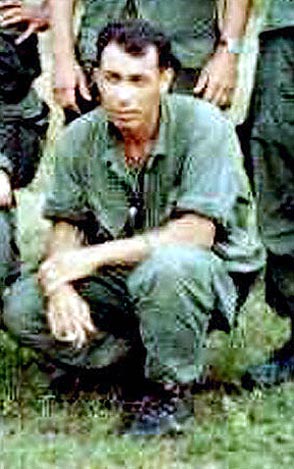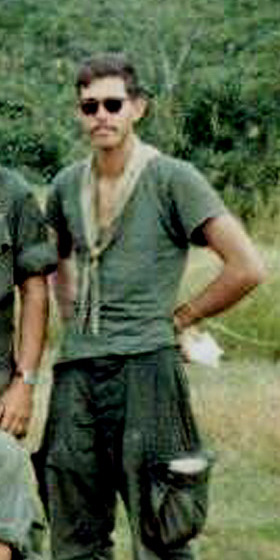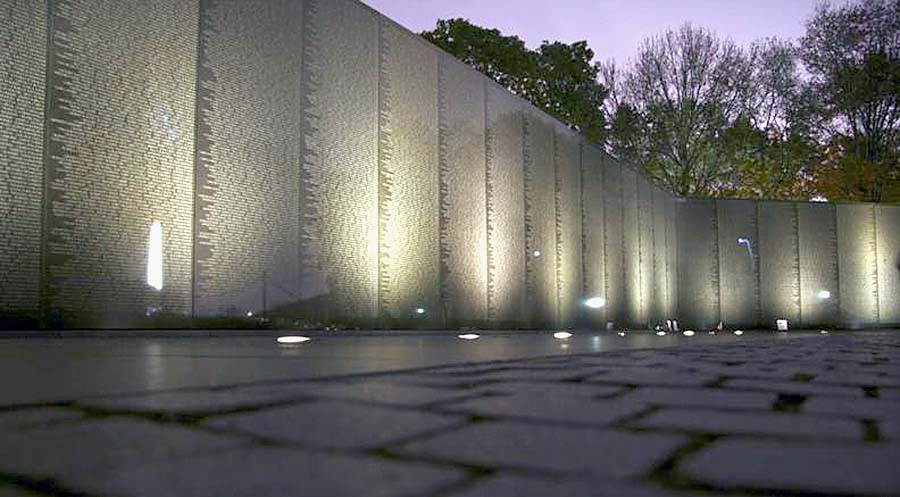
Lt Bert G. Landau
Memories
ARRIVING IN THE FIELD AS A NEW FO
Lt
Ed Thomas was not only the guy I replaced, he was a good friend and mentor.
Ed saw how skinny I was and told me that a real combat pack might kill me.
He suggested that I shouldn't try one until I got into better shape for humping
through the hills. So he fashioned a sandbag into a small backpack with straps
and suggested I use it for a while. You have to remember how skinny those
sandbags were. After telling me to dump the extra clothing, including dyed
underwear, he loaded the pack with a poncho liner, a poncho, spare ammo clips, a
few hand grenades and some C rats. I snuck in some of the underwear.....but
threw them away by week #2. For me, it was a full load for those first weeks.

FIRE MISSION: U-F-O
From LZ Incoming ~ a very busy place ~ in
about April [?] '68, I reported lights moving in the sky to the west, across the
black line. No one seemed interested at battalion or higher. But everyone agreed
that the lights were not ours. I was pretty cautious about firing on them after
that unfortunate incident involving a US Navy LST on my very first fire mission in
Nam on my first day with C/1/35.
Since the lights appeared in the same place at about the same time each night,
after several assurances that they weren't ours, I had FDC plot where I thought
they were passing through and planned a Battery 2 with VT and a good
spread. At the time when the lights would generally appear and be moving ,
I fired the battery and the lights appeared at about the same time.
No idea whether we hit anything but the lights disappeared forever. You guys can
talk about UFOs and Russian choppers but in my heart, I just knew they were US
Navy choppers, still hunting for me after the unfortunate LST accident.
{See Bert's "War Story" entitled "Shore Battery Warfare"}

Don't Be A "Tunnel Rat"
I went into a tunnel once and 2/9th Bn Co LtCol Gerald Bobzien heard about it.
His "speech" to me when he next visited C Company was a masterpiece of creative butt chewing. The crux of it was to the effect that, after the courts martial, I would be sentenced to cleaning latrines in the base camp for the rest of my tour.

LZ Mile High / LZ
Incoming/Tam Ky
I coulda sworn that
"my" LZ Incoming was within easy
105mm range of the border – maybe charge 6. There were a number of times
when we fired over the line while there. And a number of times when we fired on
the line, too. Trees were so heavy that even with fuse delay, getting a round on
the ground was difficult. Charge 6 put the border about 8 k away. I think the
story is right but with the wrong unit on the hill. We did lose 2 guns for a
short time. One was hit earlier with RPGs before the main event started.
I can’t remember how the second gun was destroyed. The ammo bunker blowing up
did as much damage as anything else. LZ Mile High was the bigger hill
overlooking LZ Incoming. It was cleared off with a "daisy cutter" bombs
immediately before the CA. I think the original intent was to put the battery
there but the heavy trees that were blown down were impossible to move and were
too big to use as parapet walls, too. We may have had the battery there for a
while anyway before giving it up and moving on to Incoming. Mile High was as
rough a place to be as Incoming but for different reasons. We were surrounded
and the enemy was wearing new uniforms, had great equipment and seemed to be far
better organized than we were. After a particularly well staged ambush of one of
our companies, I remember taking men from the battery into the ambush area to
pick up the dead bodies, discovering that a few very badly wounded were also
there. The infantry unit was so chewed up that they couldn’t even provide
security for us. The NVA 325C Division had policed the battle area and put the
Americans in one place along the edge of the ambush trail. I was dead certain
they were watching us as we shouldered our weapons and began carrying the bodies
back up the hill. The heavy jungle and huge trees made the hill always seem dark
and foreboding – gave us all the creeps. We were so glad to leave for that
smaller relatively bald hill just below us; the one named "Incoming".

FRIENDLY FIRE INCIDENT

Lt Tony Bloemhard (KIA)
You always hate to
hear of those "friendly fire" incidents and it's even worse when
you're involved or even just nearby. You must live and re-live that
incident forever. Lt Tony Bloemhard was lost to a FF incident. Tony had
been in the Dutch Army fighting guerillas in the Dutch West Indies or

The Story of Lt Joel Matusek

{Click on both frames to read story}


The Wall
I used to go to The Wall. A lot. Mostly at night. Rainy nights were best.
It was a
dark time when I was trying to deal with the demons and memories that continued
to haunt me and wasn’t having much success. There were
others there, too. When your eyes got used to the dark,
you could see us, off in the woods. Hunkered down by the
bole of one of the trees, facing The Wall. There were a
number of suicides there. I think we were all waiting for our
turn. I finally got past it but it wasn’t
easy. I think it was when the nightmares started becoming
familiar after years of reliving some bad things.
I’ve
often wondered about the number of suicides after we tried to come "home".
From what I saw at The Wall, there must have been a lot.
MY SECOND TOUR –
1971:
The end of this war was near
When I took command
of a 175mm gun unit, we were a little south of the DMZ.
The unit appeared to be mainly composed of drug addicts.
I volunteered for the “C2”, which was a Fire Support Base (FSB) on
the DMZ and led to the subsequent reopening of Khe Sahn.
The druggies either died off in the fighting there or decided that they
had to quit if they were going to survive. Attempted
“fraggings” were a pretty regular event until I began playing, too.
Mine were rigged NOT to explode but they got the message pretty quickly
and stopped. Drug use pretty much
stopped, too. It was a rough time to
command a unit there. When I
withdrew south, there were no American combat units left on the DMZ.
All of us knew that I Corps was lost.
Webmaster’s
Note: An exchange of emails (after I returned home)
with Gary Harrington
who also served in a 175mm gun
battery, confirmed that, as the war was winding down in 1971, gun crews were
addicted to drugs and smoking weed daily.